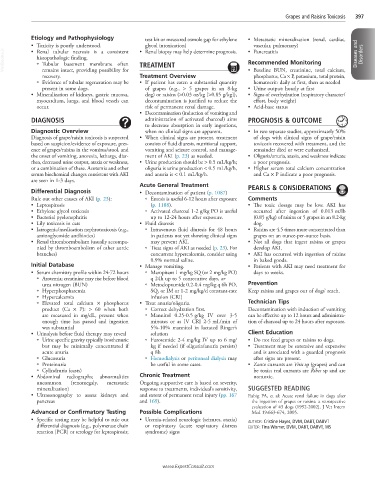Page 832 - Cote clinical veterinary advisor dogs and cats 4th
P. 832
Grapes and Raisins Toxicosis 397
Etiology and Pathophysiology test kit or measured osmole gap for ethylene • Metastatic mineralization (renal, cardiac,
vascular, pulmonary)
glycol intoxication)
• Toxicity is poorly understood. • Renal biopsy may help determine prognosis. • Pancreatitis
VetBooks.ir histopathologic finding. TREATMENT Recommended Monitoring Diseases and Disorders
• Renal tubular necrosis is a consistent
○ Tubular basement membrane often
remains intact, providing possibility for
recovery. Treatment Overview • Baseline BUN, creatinine, total calcium,
phosphorus, Ca × P, potassium, total protein,
○ Evidence of tubular regeneration may be • If patient has eaten a substantial quantity hematocrit: daily at first, then as needed
present in some dogs. of grapes (e.g., > 5 grapes in an 8-kg • Urine output: hourly at first
• Mineralization of kidneys, gastric mucosa, dog) or raisins (>0.03 oz/kg [>0.85 g/kg]), • Signs of overhydration (respiratory character/
myocardium, lungs, and blood vessels can decontamination is justified to reduce the effort, body weight)
occur. risk of permanent renal damage. • Acid-base status
• Decontamination (induction of vomiting and
DIAGNOSIS administration of activated charcoal) aims PROGNOSIS & OUTCOME
to decrease absorption in early ingestions,
Diagnostic Overview when no clinical signs are apparent. • In two separate studies, approximately 50%
Diagnosis of grape/raisin toxicosis is suspected • When clinical signs are present, treatment of dogs with clinical signs of grape/raisin
based on suspicion/evidence of exposure, pres- consists of fluid diuresis, nutritional support, toxicosis recovered with treatment, and the
ence of grapes/raisins in the vomitus/stool, and vomiting and seizure control, and manage- remainder died or were euthanized.
the onset of vomiting, anorexia, lethargy, diar- ment of AKI (p. 23) as needed. • Oliguria/anuria, ataxia, and weakness indicate
rhea, decreased urine output, ataxia or weakness, • Urine production should be > 0.5 mL/kg/h; a poor prognosis.
or a combination of these. Azotemia and other oliguria is urine production < 0.5 mL/kg/h, • Higher serum total calcium concentration
serum biochemical changes consistent with AKI and anuria is < 0.1 mL/kg/h. and Ca × P indicate a poor prognosis.
are seen in 1-3 days.
Acute General Treatment
Differential Diagnosis • Decontamination of patient (p. 1087) PEARLS & CONSIDERATIONS
Rule out other causes of AKI (p. 23): ○ Emesis is useful 6-12 hours after exposure Comments
• Leptospirosis (p. 1188). • The toxic dosage may be low. AKI has
• Ethylene glycol toxicosis ○ Activated charcoal 1-2 g/kg PO is useful occurred after ingestion of 0.013 oz/lb
• Bacterial pyelonephritis up to 12-24 hours after exposure. (0.85 g/kg) of raisins or 5 grapes in an 8.2-kg
• Lily toxicosis in cats • Fluid diuresis dog.
• Iatrogenic/medication nephrotoxicosis (e.g., ○ Intravenous fluid diuresis for 48 hours • Raisins are 4.5 times more concentrated than
aminoglycoside antibiotics) in patients not yet showing clinical signs grapes on an ounce-per-ounce basis.
• Renal thromboembolism (usually accompa- may prevent AKI. • Not all dogs that ingest raisins or grapes
nied by thromboembolism of other aortic ○ Treat signs of AKI as needed (p. 23). For develop AKI.
branches) concurrent hypercalcemia, consider using • AKI has occurred with ingestion of raisins
0.9% normal saline. in baked goods.
Initial Database • Manage vomiting. • Patients with AKI may need treatment for
• Serum chemistry profile within 24-72 hours ○ Maropitant 1 mg/kg SQ (or 2 mg/kg PO) days to weeks.
○ Azotemia; creatinine may rise before blood q 24h up to 5 consecutive days, or
urea nitrogen (BUN) ○ Metoclopramide 0.2-0.4 mg/kg q 6h PO, Prevention
○ Hyperphosphatemia SQ, or IM or 1-2 mg/kg/d constant-rate Keep raisins and grapes out of dogs’ reach.
○ Hypercalcemia infusion (CRI)
○ Elevated total calcium × phosphorus • Treat anuria/oliguria. Technician Tips
product (Ca × P): > 60 when both ○ Correct dehydration first. Decontamination with induction of vomiting
are measured in mg/dL, present when ○ Mannitol 0.25-0.5 g/kg IV over 3-5 can be effective up to 12 hours and administra-
enough time has passed and ingestion minutes or as IV CRI 2-5 mL/min of tion of charcoal up to 24 hours after exposure.
was substantial 5%-10% mannitol in lactated Ringer’s
• Urinalysis before fluid therapy may reveal solution Client Education
○ Urine specific gravity typically isosthenuric ○ Furosemide 2-4 mg/kg IV up to 6 mg/ • Do not feed grapes or raisins to dogs.
but may be minimally concentrated if kg if needed (if oliguria/anuria persists) • Treatment may be extensive and expensive
acute anuria q 8h and is associated with a guarded prognosis
○ Glucosuria ○ Hemodialysis or peritoneal dialysis may after signs are present.
○ Proteinuria be useful in some cases. • Zante currants are Vitis sp (grapes) and can
○ Cylindruria (casts) be toxic; real currants are Ribes sp and are
• Abdominal radiographs; abnormalities Chronic Treatment nontoxic.
uncommon (renomegaly, metastatic Ongoing supportive care is based on severity,
mineralization) response to treatments, individual’s sensitivity, SUGGESTED READING
• Ultrasonography to assess kidneys and and extent of permanent renal injury (pp. 167 Eubig PA, et al: Acute renal failure in dogs after
pancreas and 169). the ingestion of grapes or raisins: a retrospective
evaluation of 43 dogs (1992-2002). J Vet Intern
Advanced or Confirmatory Testing Possible Complications Med 19:663-674, 2005.
• Specific testing may be helpful to rule out • Uremia-related neurologic (seizures, ataxia) AUTHOR: Cristine Hayes, DVM, DABT, DABVT
differential diagnosis (e.g., polymerase chain or respiratory (acute respiratory distress EDITOR: Tina Wismer, DVM, DABT, DABVT, MS
reaction [PCR] or serology for leptospirosis; syndrome) signs
www.ExpertConsult.com

